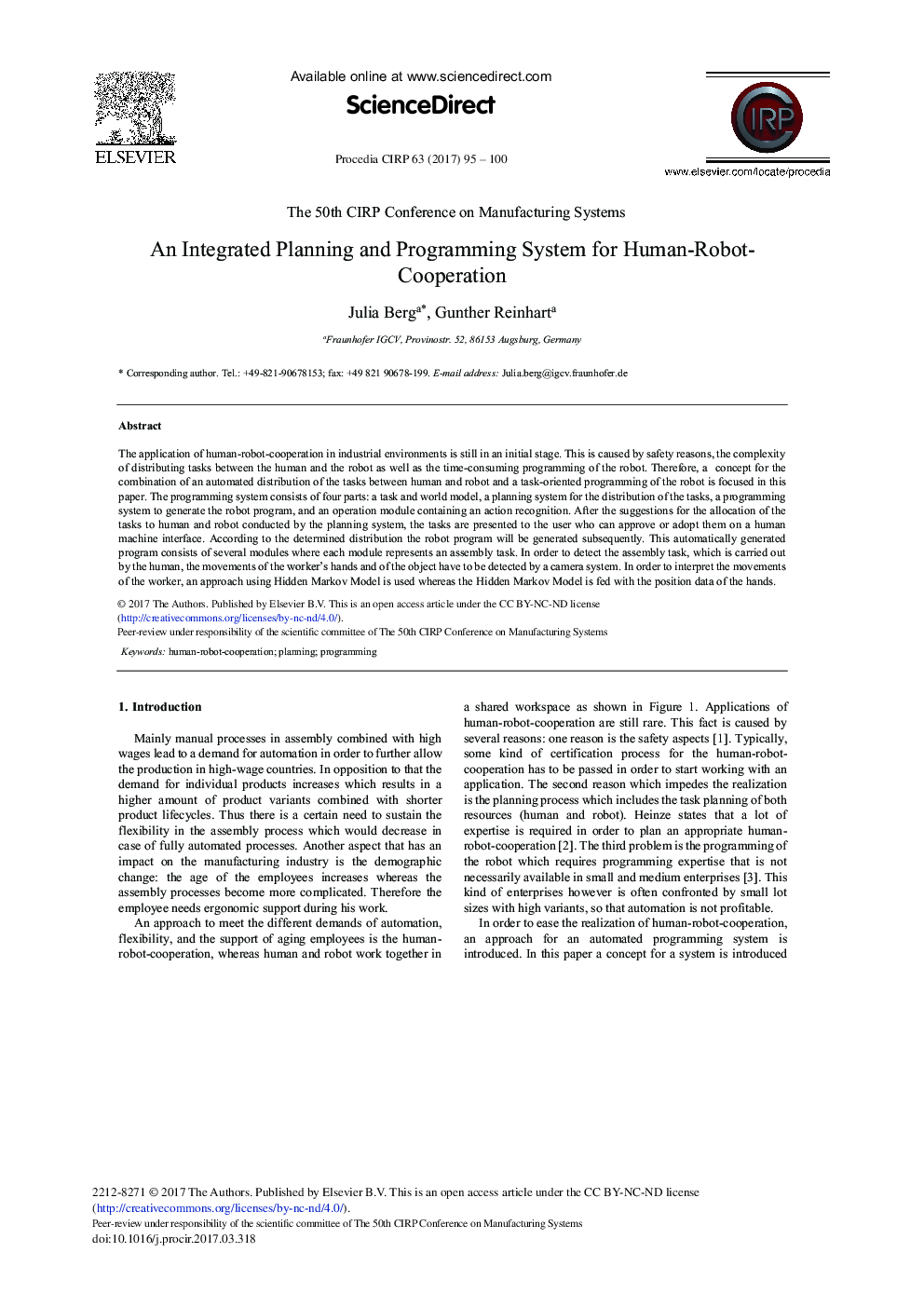| کد مقاله | کد نشریه | سال انتشار | مقاله انگلیسی | نسخه تمام متن |
|---|---|---|---|---|
| 5470130 | 1519289 | 2017 | 6 صفحه PDF | دانلود رایگان |
عنوان انگلیسی مقاله ISI
An Integrated Planning and Programming System for Human-Robot-Cooperation
ترجمه فارسی عنوان
یک سیستم برنامه ریزی و برنامه ریزی مجتمع برای همکاری روبات انسانی
دانلود مقاله + سفارش ترجمه
دانلود مقاله ISI انگلیسی
رایگان برای ایرانیان
کلمات کلیدی
همکاری انسان و روبات، برنامه ریزی، برنامه نویسی،
ترجمه چکیده
استفاده از روبات انسانی در محیط های صنعتی هنوز هم در مرحله اول است. این به دلیل دلایل ایمنی، پیچیدگی توزیع وظایف بین انسان و ربات و همچنین برنامه ریزی وقت گیر ربات است. بنابراین، مفهوم ترکیبی از توزیع خودکار وظایف بین انسان و ربات و یک برنامه ریزی کارآمد از ربات در این مقاله متمرکز شده است. سیستم برنامه نویسی شامل چهار بخش است: یک مدل وظیفه و جهانی، یک سیستم برنامه ریزی برای توزیع وظایف، یک سیستم برنامه نویسی برای تولید برنامه ربات و یک ماژول عملیاتی که دارای تشخیص عمل است. پس از پیشنهادات برای تخصیص وظایف به انسان و ربات که توسط سیستم برنامه ریزی انجام می شود، وظایف به کاربر ارائه می شود که می تواند آنها را براساس رابط کاربری انسان تایید یا پذیرفته باشد. با توجه به توزیع مشخص شده، برنامه ربات بعدا تولید خواهد شد. این برنامه به صورت خودکار تولید شده شامل چندین ماژول است که هر ماژول یک کار مونتاژ را نشان می دهد. برای شناسایی کار مونتاژ، که توسط انسان انجام می شود، حرکات دست و اشیاء کارگر باید توسط یک سیستم دوربین شناسایی شود. به منظور تفسیر حرکات کارگر، یک رویکرد با استفاده از مدل پنهان مارکف استفاده می شود در حالی که مدل پنهان مارکوف با داده های موقعیت دست ها تغذیه می شود.
موضوعات مرتبط
مهندسی و علوم پایه
سایر رشته های مهندسی
مهندسی صنعتی و تولید
چکیده انگلیسی
The application of human-robot-cooperation in industrial environments is still in an initial stage. This is caused by safety reasons, the complexity of distributing tasks between the human and the robot as well as the time-consuming programming of the robot. Therefore, a concept for the combination of an automated distribution of the tasks between human and robot and a task-oriented programming of the robot is focused in this paper. The programming system consists of four parts: a task and world model, a planning system for the distribution of the tasks, a programming system to generate the robot program, and an operation module containing an action recognition. After the suggestions for the allocation of the tasks to human and robot conducted by the planning system, the tasks are presented to the user who can approve or adopt them on a human machine interface. According to the determined distribution the robot program will be generated subsequently. This automatically generated program consists of several modules where each module represents an assembly task. In order to detect the assembly task, which is carried out by the human, the movements of the worker's hands and of the object have to be detected by a camera system. In order to interpret the movements of the worker, an approach using Hidden Markov Model is used whereas the Hidden Markov Model is fed with the position data of the hands.
ناشر
Database: Elsevier - ScienceDirect (ساینس دایرکت)
Journal: Procedia CIRP - Volume 63, 2017, Pages 95-100
Journal: Procedia CIRP - Volume 63, 2017, Pages 95-100
نویسندگان
Julia Berg, Gunther Reinhart,
